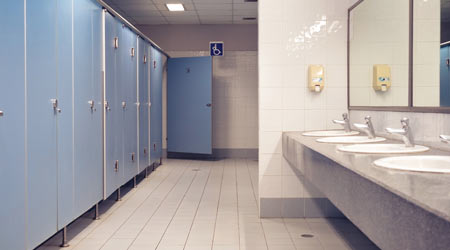 Managers planning plumbing upgrades need to focus on the key products — toilets, urinals and faucets — whose performance and reliability will determine the project’s long-term success.
Managers planning plumbing upgrades need to focus on the key products — toilets, urinals and faucets — whose performance and reliability will determine the project’s long-term success.Plumbing Products That Ensure Successful Upgrades
Toilets, urinals and faucets are key components of plumbing and restroom upgrades that deliver water conservation and savings
Water conservation is a high priority in most institutional and commercial facilities, with many regions of the country facing strict limits on water use. While many of these limitations focus on irrigation limitations, the water facilities use also has come under much closer scrutiny.
Before undertaking a plumbing or restroom upgrade, managers need to determine the goals of the project as they relate to their facilities’ current water use and anticipated water needs. They also need to focus on the key plumbing products — toilets, urinals and faucets — whose performance and reliability will go a long way toward determining the overall success of the project.
Setting goals
When planning projects to conserve water, managers typically focus on flush and flow fixtures. Flush fixtures include toilets and faucets, and flow fixtures include faucets.
To ensure a project’s success, managers should become familiar with several national green building standards, many of which have similar maximum flush and flow rates across all fixtures. These references include:
• CalGreen, the nation’s first mandatory green building standards code
• Leadership in Energy and Environmental Design (LEED) rating system
• ASHRAE Standard 189.1 — International Green Construction Code
• ASHRAE Standard 191 — Standard for the Efficient Use of Water in Building Mechanical Systems
• IAPMO Green Plumbing and Mechanical Code
• International Green Construction Code.
While most of these standards limit the allowable flush and flow rates for each fixture — and some have additional performance metrics — LEED does not require using any particular fixture. Instead, there must be an overall reduction in water use in the building or project compared to a baseline. This is a prerequisite for LEED certification, and additional points are available for exceeding set reduction limits. Managers and the design or renovation team need to understand which of these standards is applicable to any given project, as these requirements fall into different categories of code, ANSI standards and guidelines.
If none of the standards are mandatory, it is still a good idea to identify which system to align with as a part of the owner’s project requirements in order to be prepared when the bar is raised and these upgrades become mandatory. It is more cost-effective to make these improvements during a planned upgrade or renovation, compared to a mandatory, last-minute change that has to be executed without the proper planning.
Related Topics:














